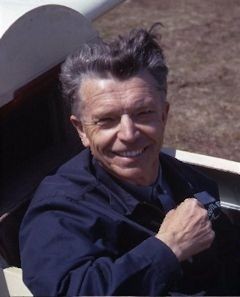Rudolph Opitz
1993
about
(1910-2010) National Competition; Test Pilot (Me-163 Rocket Airplane); Flying Wing Promoter; Flight Examiner
Awards
Barnaby Lecture 1988; Silver #116 (Germany) 1935; Gold #6 (Germany) 1938; Diamond #6 (Int #10) 1952
Bio

Rudi Opitz is an unusual member of the United States Soaring Hall of Fame

because most of his fame comes as a test pilot in Germany before and during World War II. However, his accomplishments and contributions to soaring in the United States merit his inclusion in our Hall of Fame.
He was born on August 9, 1910 in Landeshut, a town in the Silesia part of Germany. He taught himself to fly in a homebuilt glider and then received formal instruction in 1932. He then entered several gliding competitions.
From 1941 to 1945 he was the chief military test pilot for the Me-163A and Me-163B rocket powered interceptor aircraft. We urge you to consult the Internet and other sources for information on this part of his life. The ME-163 Komet was a tailless rocket powered interceptor - the fastest aircraft to see combat in WW II - well over 600 mph in level flight. At the end of the war, Rudi came to the United States to work at Wright Patterson Air Force base. He became a U.S. Citizen in 1955.
In 1956 he went to work for Lycoming in Connecticut as Chief of Flight Test Operations. For over three decades, he served as an FAA pilot examiner for glider private, commercial and flight instructor ratings. He loved flying sailplanes and volunteered his time providing thousands of hours of flight instruction as an instructor with the Nutmeg Soaring Association glider club.

Rudi Opitz was in demand as a speaker for many diverse organizations. He was awarded the New England Soaring Council Flight Instructor in 1982, Honorary Fellow of the Society of Experimental Test Pilots in 1984, Aero Club of New England Connecticut State Award in 2007.

Opitz maintained an interest in Flying Wings and is shown here with NASA Aerodynamicist and Chief Scientist at Armstrong Flight Research Center, Al Bowers, attending a conference on Flying Wings at the National Soaring Museum.
He exhibited this interest when he agreed to rebuild a Horton glider in this country if the owner would let him fly it in competition for the season - without insurance. His description at the Barnaby Lecture he gave in 1988:
"I took off and I had my hands full. I was very glad that Floyd (Sweet) was towing. I realized . . . the inadequate directional stability of that aircraft, so that even when I towed with the longest tow rope, that the tow angle, if I departed from the ideal position, would become critical. I managed to come high enough to make it back to the airport and make a good landing."
The next day he left to start the competition season.
"I won two meets in the Horton IV and then I went to the Texas Nationals; I insisted on the 300 foot tow rope or I wouldn't take off. Anyway, I found out that Texas is a big country and I got lost on one of the tasks . . . and that cost me because I couldn't make it up in the end. Even so, I finished 7th. . ."
Rudi Opitz earned Diamond #6 (Int # 10) in 1952. He also holds German Silver Badge #116 earned in 1935 and German Gold Badge #6 earned in 1938. Rudi Opitz passed away on May 1, 2010 after 99 years of an adventurous life in aviation.